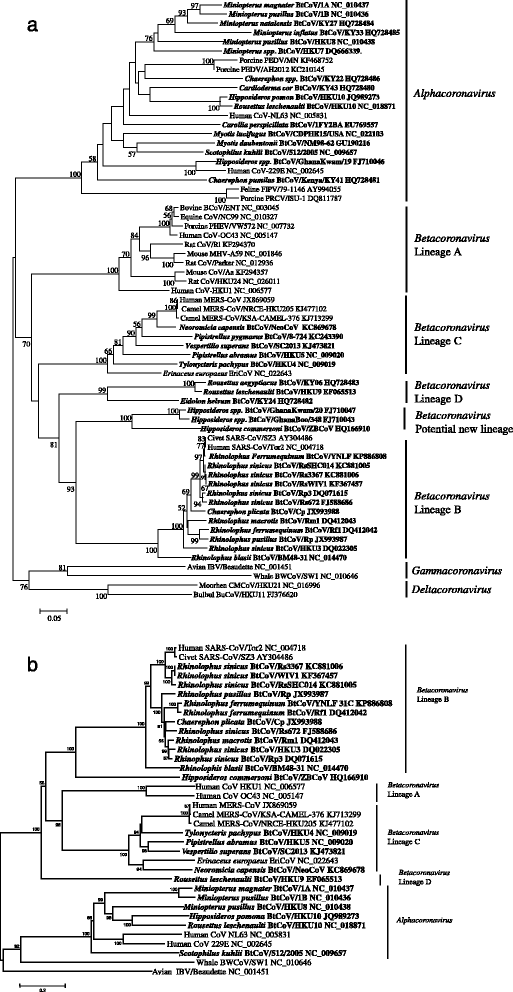Bat origin of human coronaviruses
- PMID: 26689940
- PMCID: PMC4687304
- DOI: 10.1186/s12985-015-0422-1
Bat origin of human coronaviruses
Abstract
Bats have been recognized as the natural reservoirs of a large variety of viruses. Special attention has been paid to bat coronaviruses as the two emerging coronaviruses which have caused unexpected human disease outbreaks in the 21st century, Severe Acute Respiratory Syndrome Coronavirus (SARS-CoV) and Middle East Respiratory Syndrome Coronavirus (MERS-CoV), are suggested to be originated from bats. Various species of horseshoe bats in China have been found to harbor genetically diverse SARS-like coronaviruses. Some strains are highly similar to SARS-CoV even in the spike protein and are able to use the same receptor as SARS-CoV for cell entry. On the other hand, diverse coronaviruses phylogenetically related to MERS-CoV have been discovered worldwide in a wide range of bat species, some of which can be classified to the same coronavirus species as MERS-CoV. Coronaviruses genetically related to human coronavirus 229E and NL63 have been detected in bats as well. Moreover, intermediate hosts are believed to play an important role in the transmission and emergence of these coronaviruses from bats to humans. Understanding the bat origin of human coronaviruses is helpful for the prediction and prevention of another pandemic emergence in the future.
Figures

Similar articles
-
Evolutionary insights into the ecology of coronaviruses.J Virol. 2007 Apr;81(8):4012-20. doi: 10.1128/JVI.02605-06. Epub 2007 Jan 31. J Virol. 2007. PMID: 17267506 Free PMC article.
-
Surveillance of Bat Coronaviruses in Kenya Identifies Relatives of Human Coronaviruses NL63 and 229E and Their Recombination History.J Virol. 2017 Feb 14;91(5):e01953-16. doi: 10.1128/JVI.01953-16. Print 2017 Mar 1. J Virol. 2017. PMID: 28077633 Free PMC article.
-
Identification of diverse alphacoronaviruses and genomic characterization of a novel severe acute respiratory syndrome-like coronavirus from bats in China.J Virol. 2014 Jun;88(12):7070-82. doi: 10.1128/JVI.00631-14. Epub 2014 Apr 9. J Virol. 2014. PMID: 24719429 Free PMC article.
-
Ecology, evolution and classification of bat coronaviruses in the aftermath of SARS.Antiviral Res. 2014 Jan;101:45-56. doi: 10.1016/j.antiviral.2013.10.013. Epub 2013 Oct 31. Antiviral Res. 2014. PMID: 24184128 Free PMC article. Review.
-
Bat Coronaviruses in China.Viruses. 2019 Mar 2;11(3):210. doi: 10.3390/v11030210. Viruses. 2019. PMID: 30832341 Free PMC article. Review.
Cited by
-
Classification of SARS-CoV-2 sequences as recombinants via a pre-trained CNN and identification of a mathematical signature relative to recombinant feature at Spike, via interpretability.PLoS One. 2024 Aug 26;19(8):e0309391. doi: 10.1371/journal.pone.0309391. eCollection 2024. PLoS One. 2024. PMID: 39186542 Free PMC article.
-
Middle East Respiratory Syndrome Coronavirus Could be a Priority Pathogen to Cause Public Health Emergency: Noticeable Features and Counteractive Measures.Environ Health Insights. 2024 Aug 15;18:11786302241271545. doi: 10.1177/11786302241271545. eCollection 2024. Environ Health Insights. 2024. PMID: 39156879 Free PMC article.
-
Climate Changes and COVID-19.Adv Exp Med Biol. 2024;1458:217-231. doi: 10.1007/978-3-031-61943-4_14. Adv Exp Med Biol. 2024. PMID: 39102199 Review.
-
Gastrointestinal parasitic helminths of bats from a cave in Luzon Island, Philippines.Helminthologia. 2024 Jul 16;61(2):151-165. doi: 10.2478/helm-2024-0016. eCollection 2024 Jun. Helminthologia. 2024. PMID: 39040805 Free PMC article.
-
A trivalent protein-based pan-Betacoronavirus vaccine elicits cross-neutralizing antibodies against a panel of coronavirus pseudoviruses.NPJ Vaccines. 2024 Jul 22;9(1):132. doi: 10.1038/s41541-024-00924-x. NPJ Vaccines. 2024. PMID: 39034332 Free PMC article.
References
-
- de Groot R, Baker S, Baric R, Enjuanes L, Gorbalenya A, Holmes K, et al. Family Coronaviridae. In: King A, Adams M, Cartens E, Lefkowitz E, et al., editors. Virus Taxonomy; Ninth Report of the International Committee on Taxonomy of Viruses. San Diego: Academic; 2012. pp. 806–28.
-
- Woo PC, Lau SK, Lam CS, Lau CC, Tsang AK, Lau JH, et al. Discovery of seven novel Mammalian and avian coronaviruses in the genus deltacoronavirus supports bat coronaviruses as the gene source of alphacoronavirus and betacoronavirus and avian coronaviruses as the gene source of gammacoronavirus and deltacoronavirus. J Virol. 2012;86(7):3995–4008. doi: 10.1128/JVI.06540-11. - DOI - PMC - PubMed
Publication types
MeSH terms
Grants and funding
LinkOut - more resources
Full Text Sources
Other Literature Sources
Miscellaneous

